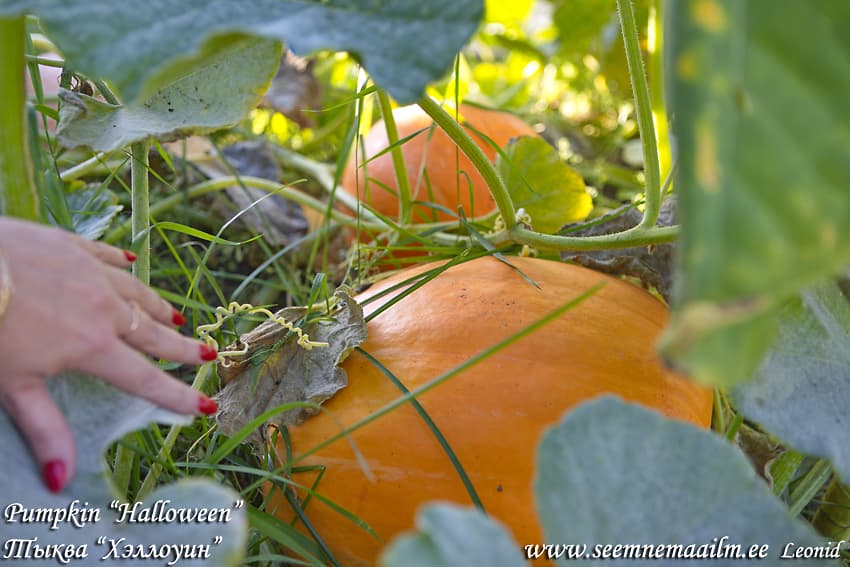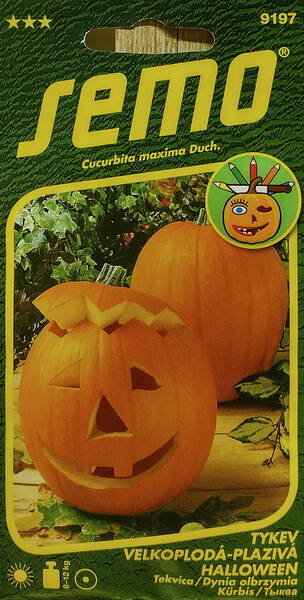Early maturing, cold-resistant, high-yielding table variety. The fruits are round, segmented, very large, 8-10 kg.
Pulp of excellent taste, bright orange, crispy, very fragrant, with a high content of carotene and sugars.
Nutritional and dietary properties are high.
The variety has high transportability, excellent keeping quality and disease resistance.
Sowing in open ground in late May-early June, in holes of 2-3 pieces, to a depth of 5-6 cm, with a step between holes of 70 cm. After germination, thin out.
You can also grow seedlings: planting 20-day-old seedlings in the open ground when the threat of frost has passed.
The main stem is pinched over the 4th leaf, 1-2 ovaries are left on the lateral ones.
Landing pattern: 70x70 cm.

FEATURES OF GROWING.
Pumpkin is a heat-loving crop. It requires not only soil moisture but also air. The culture has a powerful root system that goes deep into the ground.
Pumpkin does not like stagnant water, so it is advisable to plant them on a hill. It grows well not only on the ground but also on a dunghill.
A place for planting is selected sunny, and the soil is well fertilized. Since the pumpkin occupies a large area, it is better to plant it along the fence, directing the whips to the fence.
Bush forms are grown in the beds, placing the lashes under the trees.
Pumpkin seeds germinate for a long time, and the plant itself develops for a long time (120-140 days). Therefore, it is best to grow it through seedlings.
Sowing for seedlings begins 25-35 days before planting in the ground (in Estonian conditions, this is the beginning of May).
It is better to sow not in boxes, but in separate glasses, as the pumpkin does not tolerate transplanting.
Water the seedlings with warm water (+25ºС), and feed 1-2 times with mineral fertilizers (1 tablespoon per 5 litres of water).
In Estonia, seedlings are planted in the garden on June 10-12, under cover - on May 20-25. It is better to plant it on high beds (20-25 cm).
If you have not managed to grow seedlings, then sow the seeds in a permanent place, but not earlier than May 25th.
Pre-soak them in water or germinate in wet sawdust until a small root tip appears. The depth of sowing seeds is 8-12 cm.
CARE.
Pumpkin care consists of watering, fertilizing, loosening, mulching the soil and forming a bush. Water it not often, but plentifully.
During flowering, watering is slightly limited. In order not to wash the pollen from the flowers, water it under the root, into the hole.
Two weeks after planting, the plants are fed with mullein infusion (1 bucket per plant) with diluted nitrophoska (2 tablespoons).
After 15 and 30 days, feeding is repeated.
If the pumpkin lashes are not pinched, then they can grow up to 5-7 meters, as a result of which a lot of nutrients will be spent on the formation of greenery,
a large number of small pumpkins will be tied up, which will not have time to ripen.
In order to get a good harvest, the plant must be formed into 1-3 stems, leaving 1-2 fruits on each.
When the main stem reaches a length of 1.5-2 meters and 1-2 ovaries appear on it, the tip of the whip should be pinched, leaving 4-5 leaves behind the last ovary.
Side lashes leave 1-2 pieces, the rest are removed. The left whips can be sprinkled and pinned to the ground.
They root easily, and then the fruits receive much more nutrients and ripen faster.
The pumpkin is harvested in dry weather from September 1 to September 15, cut off along with the stalk. In no case should you take the stalk - it can fall off, and then the pumpkin runs the risk of rotting during storage.
The optimum storage temperature is +5+8 degrees. Pumpkins are well stored in room conditions without direct sunlight.
If there are no storage conditions that meet the necessary standards, then the pumpkins are processed: frozen, dried, boiled jam, candied fruits.
The best specimens are left until spring for seeds.
* From a botanical point of view, a pumpkin is a juicy fruit containing many seeds. Pumpkin is considered the largest berry in the world. Its individual fruits reach 100 or more kilograms.
So, for example, in the USA in 1986, one farmer grew a pumpkin weighing 302 kg.
Of course, in Estonia, due to climatic conditions, such results cannot be achieved, but in the southern regions, a pumpkin of 30-40 kg is a common thing...















